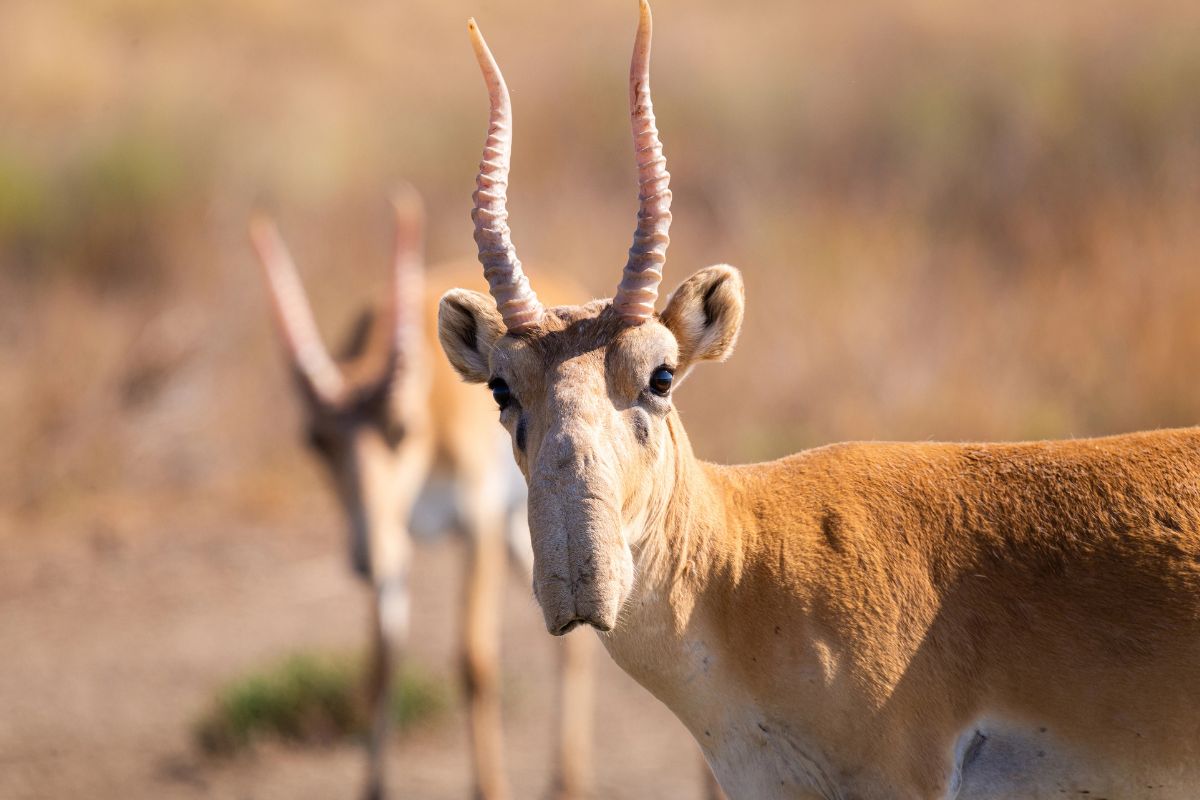The saiga antelope, a prehistoric creature known for its distinct appearance, has made a remarkable comeback from the brink of extinction in Kazakhstan. With its trunk-like nose and ancient lineage dating back to the Ice Age, this resilient species has overcome numerous challenges to reclaim its territory on the vast Kazakh steppes.
Ancient survivors: the remarkable journey of saiga antelopes
Saiga antelopes have roamed Earth for thousands of years, once sharing landscapes with woolly mammoths and rhinos. These ancient creatures were immortalized in rock art created by early humans approximately 19,000 years ago, demonstrating their historical significance across continents. Their prehistoric origins are fascinating to scientists studying evolutionary adaptation in changing environments, similar to how researchers examine mysterious celestial systems like Nu Octantis to understand cosmic evolution.
The saiga’s most distinctive physical feature is its unusually large, flexible proboscis that helps filter dust in summer and warm cold air in winter. This adaptation allowed the species to thrive across vast territories that once stretched from Canada to France. Today, their range has dramatically contracted, with the main population concentrated in Kazakhstan and smaller groups surviving in Uzbekistan, Russia, and Mongolia.
Their reproductive capabilities have played a crucial role in their survival strategy. About 60% of female saigas give birth to twins rather than single calves, enabling rapid population recovery under favorable conditions. This biological advantage mirrors natural resilience systems observed in various species, reminding us that even the most vulnerable organisms can rebuild their numbers when given appropriate protection and habitat.
YearSaiga Population in KazakhstanConservation Status200321,000Critically Endangered2015Major decline due to disease outbreakCritically Endangered20242.8 millionNear Threatened
From hunting grounds to protected territories
The 20th century brought devastating challenges to saiga populations. Intensive hunting campaigns in the mid-1900s pushed these unique antelopes toward extinction. Both Chinese and Soviet poachers targeted them for their meat, hides, and particularly their horns, which are valued in traditional medicine. According to the International Union for Conservation of Nature (IUCN), approximately 150,000 antelopes were killed annually during the 1950s and 1960s.
By 2002, the dramatic population decline led to saigas being classified as critically endangered. Facing a genuine extinction threat, Kazakhstan’s government took decisive action in 1999 by implementing a comprehensive hunting ban. This pivotal decision was reinforced with specialized education and training programs for border guards to combat poaching and smuggling effectively.
A major conservation milestone came in 2006 with the establishment of the Altyn Dala Conservation Initiative, dedicated to preserving the wildlife of the Kazakh steppe, including the saiga antelope. Their efforts have secured protected land equal in size to Denmark. This conservation success story parallels other ambitious environmental projects, such as SpaceX’s innovative approaches to space exploration, where careful planning and bold action create remarkable results.
The protected territories continue to expand, as Daniyar Turgambayev, chair of the forestry and wildlife committee at Kazakhstan’s Ministry of Ecology and Natural Resources, confirmed the government’s commitment to designate up to 30% of the country as wildlife sanctuaries. “Naturally, given that Kazakhstan is the ninth-largest country in the world, this is a huge territory,” he emphasized.
Disease challenges in a warming world
Despite their population rebound, saiga antelopes face ongoing threats from disease outbreaks. The species has experienced four major health crises in the past 15 years alone. The most devastating occurred in 2015, when a bacterial infection decimated over half the global saiga population in just three weeks. Similar to how scientists study blood samples to detect infection risks, wildlife researchers continuously monitor saiga herds for early disease signs.
The IUCN has identified that these bacterial infections are likely triggered by warmer-than-usual temperatures during calving season. This connection between climate change and wildlife health represents a significant concern for conservation efforts. As global temperatures continue to rise, the saiga’s vulnerability to disease may increase, creating new challenges for their long-term survival.
To address these threats, conservation organizations implement several protective measures:
Regular health monitoring of saiga populations
Scientific research into disease resistance and prevention
Habitat protection to reduce environmental stress
Biodiversity preservation across the steppe ecosystem
The future of this prehistoric survivor
The saiga antelope’s recovery represents one of the most remarkable conservation success stories in recent decades. From a perilous population of just 21,000 in Kazakhstan in 2003, their numbers have soared to 2.8 million in 2024. This dramatic rebound has allowed the species to be downgraded from “critically endangered” to “near threatened” on the IUCN Red List.
The saiga’s resilience mirrors the adaptability that has allowed them to survive since prehistoric times. Their recovery demonstrates how effective conservation efforts can reverse even severe population declines when implemented comprehensively. This success offers valuable insights for other endangered species recovery programs, similar to how xenotransplantation research provides critical understanding of biological adaptation.
Scientists continue studying how these ancient animals communicate and interact within their herds, revealing sophisticated social structures. Their communication patterns show complexity comparable to other social species, reminiscent of research showing how different neurological groups communicate effectively despite varying approaches.
The saiga’s story also parallels greater geological transformations. Just as these prehistoric creatures have adapted to changing landscapes over millennia, our planet continues its own dramatic transformations, including how the African continent is gradually splitting along the East African Rift. These parallel narratives remind us of nature’s constant evolution and the importance of protecting Earth’s diverse biological heritage.

